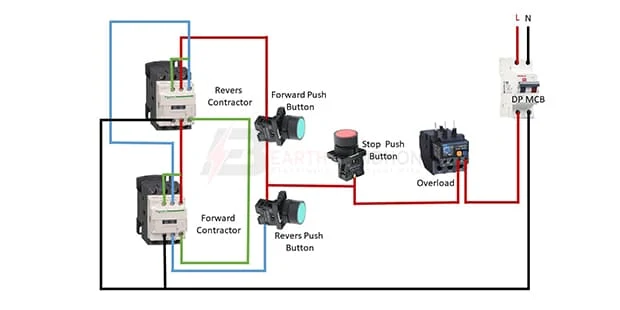Reverse Forward Starter Control wiring Diagram:
This diagram shows how to make the Reverse Forward Starter Control Wiring Diagram. Forward Reverse Motor Control. In this circuit, we use a DP MCB ( Double Pole Minature Circuit Breaker ), two magnetic contactors, and three push switches. We need to connect all components like our diagram. Now this circuit is ready for use. If you want to know more about this circuit please check our youtube video below the post.
Diagram of Forward Reverse motor control wiring:
Components Need for this Project:
You can get the components from any of the sites below:
- DP MCB [See Buy Click Amazon]
- Contactor [See Buy Click Amazon]
- NO Switch [See Buy Click Amazon]
- NC Switch [See Buy Click Amazon]
- Overload [See Buy Click Amazon]
Read Also:
Components used to make the motor control wiring:
01. DP MCB
 |
| Fig 2: DP MCB |
Double pole MCB can control two wires. This circuit breaker is generally used in single-phase electric lines. Double pole MCB circuit breaker input has two wires supply two wires and an output. In a single-phase line, A double-pole MCB circuit breaker is used to give good production. This circuit breaker is provided through phase and neutral circuit breaker, it is very safe. This circuit breaker is preferred for home appliances. A DP MCB usually trips for 2 reasons 1. Overload 2. Short circuit.
02. Contactor
 |
| Fig 3: Contactor |
A magnetic contactor is an electrical device used for load control, automation, and protection. It is much like a magnetic reel. However, relays are generally used for low power and voltage, on the other hand, when we think of high power, these heavy-duty contractors only come to mind. It basically works by switching the load on and off. It has 3 terminals whose inputs are denoted as L1, L2, L3, and outputs as T1, T2, and T3. The circuit of the load is made in automation mode or protection using auxiliary contacts. It has two types of terminals. 1) Normally Open (NO). 2) Normally Closed (NC)
03. NO Switch
 |
| Fig 4: NO Switch |
The operator switch has its contact in Normally Open condition. To make Ladder Logic you need to understand NO contact. A Classic Switch has one Input And one Output. In "No Switch," YoungBoy Raps About Ammunition, Murder, Firearms, and Firearm Attachments Such as a Switch. The contact of the switch whose contact is already open is NO. That is enough to understand. no switch in a circuit, then the circuit will not function as intended. to write a program such that when the red light is on, This switch is now in normally open condition. When you push the switch it will close and the red light will turn on.
04. NC Switch
 |
| Fig 5: NC Switch |
Indicates the contacts of switches or automatic actionable devices. Simply put, the push switches, magnetic contactors, and relays that we use in the factory Normally have Close Contact exists. At this moment the switch will be in normally closed condition. Because already he is sitting close. When turned off the contact will open. To make ladder logic you need to understand NC contact. As already explained. The switch contact is already closed in NC. That is enough to understand.
05. Overload
 |
| Fig 6: Overload |
Overload relays are often used to protect the motor from excessive current flow. Overload relays are used to protect the motor from overheating. Besides some specific faults such as phase to phase, phase to ground, etc. overload relay provides protection to the motor. A thermal overload relay works on the principle of bimetallic strip electro-thermal characteristics. When the bimetallic heats up, the trip function in the overload relay turns on and disconnects the power supply to the contactor coil, thus tripping the overload relay and breaking the motor current and saving the motor.
Thank You for visiting the website. Keep visiting for more Updates.
Frequently Asked Questions
To change the direction of a three-phase induction machine rotation, two of its phases need to be exchanged, thus changing the phase sequence form, say ABC to CBA. This can be accomplished by using 2 contactors, one for the forward or CW rotation and one for the reverse or CCW rotation.
The Reversing Starter is a special type of push button starter wherein addition to starting or stopping of motors the director of rotation of a three-phase induction motor can be done by interchanging the connection of any 2 terminals of the supplies which is done through 2 separate contactors, one for forward and.
The direction of rotation of a three-phase induction motor can be reversed by interchanging any 2 of the three motor supply lines. Such that the field rotates counterclockwise rather than clockwise. However, the number of the poles or the speed at which the magnetic field rotates remains unchanged.
Forward or reverse connection motors can be used in various applications where you need to control the direction of the rotation. Some common examples include conveyor systems, winches, cranes, or other machinery where the ability to control both forward or reverse motion is necessary.
To control the direction of the motor, the pins in and in two must be set to opposite values. If in1 is HIGH and into is LOW, the motor will spin one way, if on the other hand, if in1 is LOW and into HIGH then the motor will spin in the opposite direction.


Post a Comment
Do leave your comments